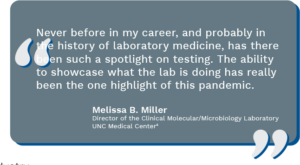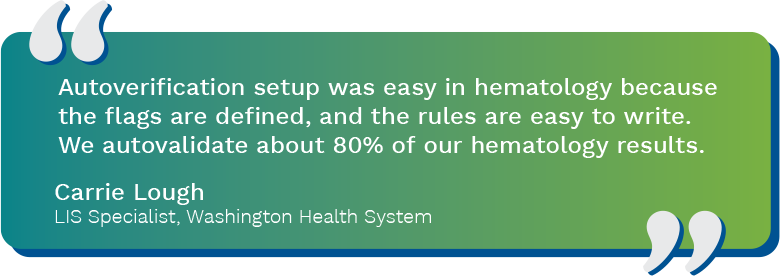Abstract
The laboratory industry faces continuing workforce shortages that create challenges affecting work quality and turnaround times. Successful labs are facing this with strong recruitment and retention efforts and process improvements achieved by leveraging every possible technical solution to its maximum capability.
 Laboratories are continually assessing new technologies, regulations, and challenges. The laboratory industry has faced a workforce shortage for many years that has been exacerbated by the COVID-19 pandemic and which is reaching a crisis-level in some areas. There is no immediate relief for this staffing shortage in sight. As a result, many labs continue to work short-staffed, making it imperative that laboratories are as efficient and productive as possible. Productivity tools such as a Laboratory Information System (LIS) can help automate workflows and embed safety features that allow laboratory professionals to “do more with less.”
Laboratories are continually assessing new technologies, regulations, and challenges. The laboratory industry has faced a workforce shortage for many years that has been exacerbated by the COVID-19 pandemic and which is reaching a crisis-level in some areas. There is no immediate relief for this staffing shortage in sight. As a result, many labs continue to work short-staffed, making it imperative that laboratories are as efficient and productive as possible. Productivity tools such as a Laboratory Information System (LIS) can help automate workflows and embed safety features that allow laboratory professionals to “do more with less.”
Executive Summary
- Change within the healthcare system and the laboratory industry has become commonplace and successful laboratories must be nimble enough to shift with the changing healthcare landscape.
- Many smaller laboratories have been absorbed into larger labs as part of the ongoing rise of healthcare mergers and acquisitions.
- While the pandemic delayed pending laboratory reimbursement cuts, significant reductions still loom over the lab, threatening the viability of smaller labs.
- One of the biggest challenges laboratories face is a monumental staffing shortage.
- COVID-19 brought much-needed recognition to laboratory professionals but added enormous pressure to an already short-staffed profession.
- The most successful laboratories are focused on adapting to change, leveraging as many tools as possible to enable their maximum contribution to patient care.
- Purposeful recruitment and retention efforts are becoming more prevalent among laboratories.
- Laboratories are finding ways to increase their productivity with less staff, using internal tools and new technologies.
- A laboratory information system, when used to its maximum potential, is the most effective tool to boost productivity
Healthcare & Laboratory Industry Climate
Change within the healthcare system and the laboratory industry has become the norm and successful laboratories have had to become nimble enough to shift with the changing healthcare landscape. One of the most significant changes has been the slow shift to value-based care that has resulted in many mergers and acquisitions across the healthcare industry. The COVID-19 pandemic added tremendous stress to the healthcare system and was an additional
catalyst for vertical consolidation.
Vertical integration in healthcare

Healthcare mergers continue to rise with a record number in 2021—nearly 3,000 deals—up more than 25% from 2020 (see Figure 1).1 Recent mergers are trending toward “megamergers,” which refers to billion-dollar agreements.
This means that the number of physicians in private practice continues to decline. Between July 2020 and January 2021, there was a 3.1% increase in hospital-employed physicians, increasing with the COVID-19 pandemic. Healthcare mergers are intended to bring efficiencies and better care coordination, and to simplify the payment process. Despite this expectation, rapid hospital consolidation has increased prices with no measurable improvements in quality.2
COVID as catalyst for more mergers and acquisitions
The COVID-19 pandemic continues to fuel this consolidation trend. The largest hospitals receive the biggest chunk of COVID-19 relief payments. The pandemic created a financial burden for small independent medical practices, which may rely on a merger or acquisition to remain operational.2 With these financial pressures, mergers—and an increasing number of providers as hospital employees—are expected to continue, reducing competition and increasing prices.
There is valid concern among industry professionals that the high rate of mergers may have a significant adverse impact on patients. Toward the end of 2021, President Joseph Biden released an executive order that called for action regarding hospital consolidation. The Federal Trade Commission and the Department of Justice will review their merger guidelines to guard against concerns that hospital mergers, particularly in rural areas, can be harmful to patients.
Consolidating labs
Private practice laboratories that are part of a merger may end up dissolving as the larger hospital lab absorbs their testing volume. The trend suggests that smaller laboratories will continue to be acquired, and the large laboratories will continue to grow.
There are mixed feelings about the impact of laboratory consolidation. On one hand, consolidated labs could make it easier for patients to access and attain their lab results, with the potential to lower costs. On the other hand, there is concern within the industry that access to laboratory services will become unavailable or difficult to attain in rural areas. Because each laboratory is unique and complex, this is not a simple equation to solve.
PAMA cuts loom over labs
 The Protecting Access to Medicare Act (PAMA) of 2014 required the Centers for Medicare & Medicare Services (CMS) to establish clinical laboratory fee schedule (CLFS) payment rates based on the rates private payers reimburse for laboratory tests. Laboratories that met certain requirements were required to report their private payer rates. There was significant controversy and concern over the collection methodology and bias based on the definition of an applicable laboratory (i.e., required to report). The first round of the updated CLFS was released in 2017, resulting in significant cuts to the most common lab tests and rate increases for some newer, esoteric tests. The transition to private payer–based rates resulted in much larger payment reductions for low-cost, routine tests than for newer, more expensive tests.3
The Protecting Access to Medicare Act (PAMA) of 2014 required the Centers for Medicare & Medicare Services (CMS) to establish clinical laboratory fee schedule (CLFS) payment rates based on the rates private payers reimburse for laboratory tests. Laboratories that met certain requirements were required to report their private payer rates. There was significant controversy and concern over the collection methodology and bias based on the definition of an applicable laboratory (i.e., required to report). The first round of the updated CLFS was released in 2017, resulting in significant cuts to the most common lab tests and rate increases for some newer, esoteric tests. The transition to private payer–based rates resulted in much larger payment reductions for low-cost, routine tests than for newer, more expensive tests.3
In 2018, CMS changed the definition of applicable laboratory to include hospital outreach laboratories, broadening the data collected to gain a more accurate representation of private payer rates. In 2019, the Laboratory Access for Beneficiaries (LAB) Act delayed PAMA reporting until 2021. Finally, the 2020 Coronavirus Aid, Relief, and Economic Security (CARES) Act delayed PAMA reporting by another year with a new reporting period of January 1 to March 31, 2022. The CARES Act also capped the 2020 CLFS rates through 2021 and delayed the 15% reduction cap originally planned for 2021-2023 until 2022-2024.
While the pandemic delayed pending laboratory reimbursement cuts, the PAMA cuts are still looming over the lab, threatening the viability of smaller labs.
 Pandemic adds stress to short-staffed labs
Pandemic adds stress to short-staffed labs
The stress that the COVID-19 pandemic has placed on the laboratory has been unprecedented.
On the plus side, COVID-19 brought some much-needed recognition to the profession; however, with that recognition came an enormous amount
of pressure to an already short-staffed industry.
Laboratory Professional Workforce Shortage

One of the biggest challenges laboratories currently face is a monumental staffing shortage. COVID-19 put an extreme amount of pressure on many laboratories, exacerbating this staffing shortage. The Bureau of Labor Statistics projects the demand for clinical laboratory professionals will grow 7% from 2019 to 2029, which is nearly double the average growth rate for all occupations (see Figure 2).5
The laboratory industry is continuing to see a decrease in qualified medical laboratory scientists (MLSs) such that the number of new graduates does not meet the demand for new scientists as a generation retires. This has led to an increase in non-certified individuals performing low-to-high-complexity testing, and an increased rate of laboratory professionals taking on more responsibilities. Figure 3 lists some of the reasons for the workforce shortage.
![Graphic showing a quote from Dark Daily, "Labor shortages in [clinical] testing labs have existed for years due to factors including low recruitment, an aging workforce, and relatively low pay for [medical] lab technicians and technologists compared to that of other healthcare workers with similar education requirements.”](https://www.orchardsoft.com/wp-content/uploads/2022/03/Mitigate_Labor_Shortage_graphic6.png)
The lack of visibility of the profession combined with salaries that are not comparable to other healthcare careers with similar education requirements deters students from entering MLS programs.7 In a 2021 Whitehat Communications poll, 83% of survey participants reported that their laboratory was struggling to maintain a full staff and 78% of participants felt that MLSs receive lower pay compared to other healthcare careers with similar education requirements (see Figure 4).


Declining MLS programs

Accredited MLS programs have declined steadily for two decades, with a 7% decrease from 2000 to 2020 (see Figure 5) and a 25% decrease since 1990.8 MLS programs are training less than half of the number of graduates from accredited training programs each year, leaving a significant gap between the actual requirements and the availability of qualified MLSs.7 This shortage of graduates results in an average vacancy rate of 7% across the lab industry.8
The shortage becomes particularly evident in rural areas and in states that lack training programs, but it also affects some highly populated areas. For example, Florida and Arizona have a high elderly population that requires more healthcare services. The Bureau of Labor Statistics estimates that an additional 35,100 jobs will be added between 2018 and 2028, not counting the number of jobs that will be made available by laboratory professionals who will retire during that period.5
MLS program closings are typically budget related. The programs are expensive to maintain and tend to enroll few students. On a budget spreadsheet, the MLS program is an easy area to cut.
Hiring challenges
![Graphic showing a quote from Lisa Cremeans, MMDS, CLS(NCA), MLS(ASCP), Clinical Assistant Professor University of North Carolina at Chapel Hill saying, "[MLS Programs] are expensive to offer, so when it comes to cuts and budgets, some of those cuts have been based on how much it costs to run them. That, and they may not have high enough enrollments."](https://www.orchardsoft.com/wp-content/uploads/2022/03/Mitigate_Labor_Shortage_graphic10-300x219.png) With a smaller pool of graduates to select from, laboratory managers are faced with a competitive hiring situation. A 2018 survey by the American Society for Clinical Pathology (ASCP) found that the top two hiring challenges for laboratories are other laboratories offering better pay and benefits and increasing competition for well-trained personnel (see Figure 6).9
With a smaller pool of graduates to select from, laboratory managers are faced with a competitive hiring situation. A 2018 survey by the American Society for Clinical Pathology (ASCP) found that the top two hiring challenges for laboratories are other laboratories offering better pay and benefits and increasing competition for well-trained personnel (see Figure 6).9
The 2018 ASCP survey listed the top laboratory workforce concerns as a need for higher salaries and to heighten awareness of the laboratory profession. (See Figure 6).9

New technologies shift MLS skillsets

Another challenge to the laboratory workforce is the effect of evolving technologies. New technologies require MLSs to update their skillsets to keep up with the most current laboratory requirements. There are exciting new developments in diagnostic technologies, including improvements in preventive screening and genetic testing, and a push toward faster results to improve patient care. However, these changes mean that laboratorians need new knowledge and skills that were not expected in the past and may not have been included in their MLS education. According to the 2018 ASCP survey, the top technologies that influence staffing needs are molecular testing, automation, and LISs (see Figure 7).9
COVID-19’s impact on laboratories

In addition to the workforce challenges and billing changes affecting the industry, the COVID-19 pandemic made a huge impact on laboratory staffing needs. In 2020, there were a record number of new CLIA certifications, up 50% from 2019 (see Figure 8), adding to the need for qualified laboratory professionals.10
Even when a laboratory is not fully staffed, the work continues. Specimen viability is a constant and turnaround times (TATs) must be met. Staff shortages often cause the remaining workforce to carry out the same volume of tests as a fully staffed lab. The pandemic, combined with the national shortage of trained lab scientists, is forcing MLSs in some labs to work long hours. In many healthcare organizations, MLSs are being asked to work overtime or double shifts, with skeleton crews, and are still expected to maintain the same TATs. Over time, this pace can lead to exhaustion, burnout, and increased potential for error.
Successful Recruitment & Retention Efforts
Despite crisis-level staffing shortages, laboratories are rising to the challenge. The most successful laboratories are focused on adapting to change and leveraging as many tools as possible to enable maximum contribution to patient care. Purposeful recruitment and retention efforts are becoming more prevalent (see Figure 9).
As a result of the workforce shortage, ASCP and the University of Washington Center for Health Workforce Studies have partnered to study the issue and develop goals to help mitigate the problem. Their study—Clinical Laboratory Workforce: Understanding the Challenges to Meeting Current and Future Needs proposes innovative strategies to recruit MLSs. The proposal addresses three main areas of need:
- Improving the profession’s visibility
- Improving workforce recruitment and retention
- Promoting diversity and inclusion in the laboratory

Ideas include introducing MLS careers at the elementary level and providing tuition support and scholarships to recent graduates. Flexible schedules, generous benefits, tuition incentives, and sign-on bonuses are encouraged where possible. The study also suggests that incentives should be offered to lab employees who attend recruitment and awareness-building events, and laboratories should offer financial incentives to encourage professional development and job satisfaction. Opportunities for career growth through tier levels, pay increases, and elevated titles are also a recommended recruitment and retention strategy.11 Figure 10 lists some examples of ongoing successful recruitment and retention strategies.

Ways to Boost Productivity & Help Mitigate Staff Shortages
In addition to effective recruitment and retention efforts, laboratories are finding ways to increase their productivity with less staff, using internal tools and new technologies.
Laboratory stewardship

Laboratories are streamlining their processes by implementing laboratory stewardship programs that reduce the time labs spend performing unnecessary tests and improve communication with ordering providers. Laboratory stewardship means taking responsibility for lab testing from the time of order all the way through test interpretation to reduce errors and ensure that the appropriate tests are ordered. With an effective program in place, labs become more efficient and are focused on effective patient testing (see Figure 11).
Standardization and automation
Both patients and the laboratory can benefit from process and procedure standardization. Standardized policies, procedures, and methodologies help improve manageability, quality, and efficiency due to decreased redundancy and opportunity for errors. Removing disparities can improve efficiency, patient satisfaction, and quality of care, and provide a smooth workflow across clinical operations.
When processes and methodologies are not standardized, the differences in testing methodologies can be confusing and potentially lead to misinterpreted results. Standardization allows for uniformity of EHR and LIS setup across locations, reducing opportunities for misinterpretation. Uniform purchasing standards help obtain the most cost-effective products to drive the best patient outcomes (see Figure 12).
Automation opens another opportunity for test processing standardization. Automation lines can free staff for other duties and help eliminate opportunities for human error. Improved cost effectiveness can be realized by faster processing times that result in faster TATs and improved tube tracking abilities. An automation line can decrease repetitive injuries (e.g., carpal tunnel), and improve overall job satisfaction (see Figure 13).


Your LIS as a Productivity Tool
A laboratory information system, when used to its maximum potential, is the most effective tool to boost lab productivity. The LIS is developed with that purpose in mind. It can help fully automate the functions in a lab. This automation improves the staff’s experience, increases employee motivation, and streamlines overall lab operations (see Figure 14).

Workflow management
The connectivity that an integrated LIS provides is invaluable for a busy laboratory workflow. Having orders flow from the EHR to the LIS, to the analyzers, and back to the LIS and EHR is imperative to achieve acceptable TATs. Interfaced lab analyzers allow test results to be stored and shared across facilities automatically. Interfaces to host systems, reference labs, and billing systems help streamline lab ordering and speed up reporting.
The LIS includes extensive audit trails and sample tracking tools that allow laboratory professionals to organize and track laboratory samples throughout the testing continuum and to reduce time spent searching for samples.

Decision-support rules
Automated decision-support rules are an incredibly valuable tool to help standardize lab workflow and reduce errors. Rules can be set for pre-analytical, analytical, and post-analytical phases of testing. See Figure 15 for examples.
Performance metrics
Every laboratory requires tracking performance metrics and key performance indicators (KPIs) to measure quality and continue to make improvements. Data in your LIS should be available to help achieve quality goals, promote population health management, and close care gaps. Automated reports (e.g., utilization monitoring, staff productivity, or TAT tracking) can be set up to deliver to the desired individuals at a specific time and location. These types of automated processes save time and improve communication.
Inspection-ready QC and QA
 Your LIS should be your “one-stop shop” for tracking quality control (QC) and quality assurance (QA) activities. Both qualitative and quantitative QC, including Levey-Jennings (L-J) graphs and Westgard rules, can be made easily available for inspectors to view without the need for printing. The inspector can view multiple L-J graphs on one screen for comparison. The LIS can also be used to automate documentation of your required weekly QC review.
Your LIS should be your “one-stop shop” for tracking quality control (QC) and quality assurance (QA) activities. Both qualitative and quantitative QC, including Levey-Jennings (L-J) graphs and Westgard rules, can be made easily available for inspectors to view without the need for printing. The inspector can view multiple L-J graphs on one screen for comparison. The LIS can also be used to automate documentation of your required weekly QC review.
For QA, you can set standardized comments for unacceptable specimens and rejected tests that are tracked on the rejected orders log. Error reports with corrective action comments and remedial action reports by pre-analytical, analytical, and postanalytical can be generated as part of a comprehensive QA program. TATs can be tracked for time-sensitive tests.
Autoverification
Using the LIS for autoverification is one of the most effective ways a lab can reduce hands-on tech time through process automation. Depending on the lab menu and patient population, 40% to 80% of results could qualify for autoverification.

Autoverification is a laboratory process in which acceptable patient result parameters are defined for results generated from interfaced instruments that are sent to the LIS. Results that fall within the defined autoverification parameters automatically release into the EHR without any additional laboratory staff review or intervention. Results that are not within the defined parameters are saved for a technologist to review prior to reporting. See Figure 16 for an outline of autoverification setup steps. Autoverification helps improve quality, reduces costs, and simplifies processes. It provides consistent test reporting with dramatic improvements in TAT and reduction in error rates.

Your acceptable autoverification range defines the acceptable result limits for a lab test that can be released without technologist review. You can analyze the LIS reports from previous results for each test to determine cutoff points where it is necessary for result review. Your autoverification setup review should include sufficient test volume so that several tests fail to auto-verify. Ideally, you would like to encounter each failed scenario and ensure its proper function. See Figure 17 for some helpful resources for autoverification.

Conclusion
MLSs are part of a resilient profession who often get little recognition for an enormously valuable job. Their dedication to patient care and accurate results deserves to be commended. Even when faced with an overwhelming number of hurdles, laboratories continue to “do the right thing” and do not shy away from challenges.
In an unprecedented time, faced with a pandemic, severe staffing shortages, government regulations that affect reimbursements, and continued change, top laboratories find ways to bring efficiencies into their workflow that allow them to continue to provide a level of excellence and a focus on taking care of patients.
Strong labs are developing long- and short-term recruitment and retention plans and are using every productivity tool available, including maximizing LIS use. Challenges will continue and laboratories will adapt and remain at the heart of diagnostic medicine, with the LIS at the heart of the laboratory.
References
- Landi, H. The Top 10 Healthcare M&A Deals of 2021. Fierce Healthcare. https://www.fiercehealthcare.com/special-report/top-10-healthcare-m-a-deals-2021. December 14, 2021.
- Scheffler R, Alexander L. Consolidation of Hospitals During the COVID-19 Pandemic: Government Bailouts and Private Equity. Milbank Quarterly Opinion. https://doi.org/10.1599/mqop.2021.0720. July 20, 2021.
- June 2021 Report to the Congress: Medicare and the Health Care Delivery System. MedPAC. https://www.medpac.gov/document/june-2021-report-to-the-congressmedicare-and-the-health-care-delivery-system. June 15, 2021.
- UNC School of Medicine Clinical Laboratory Science. COVID-19 Pandemic Highlights Critical Need for Medical Laboratory Professionals. https://www.med.unc.edu/ahs/clinical/2021/02/covid19-pandemic-highlights-critical-need-for-medical-laboratory-professionals. February 2021.
- US Bureau of Labor Statistics. Occupational Outlook Handbook. https://www.bls.gov/ooh/healthcare/clinical-laboratory-technologists-and-technicians.htm. June 2021.
- Clinical Laboratories Need Creative Staffing Strategies to Keep and Attract Hard-toFind Medical Technologists, as Demand for COVID-19 Testing Increase. Dark Daily. https://www.darkdaily.com/2020/11/02/clinical-laboratories-need-creative-staffing-strategies-tokeep-and-attract-hard-to-find-medical-technologists-as-demand-for-covid-19-testing-increases. November 2020.
- ASCLS. Addressing the Clinical Laboratory Workforce Shortage. https://ascls.org/addressing-the-clinical-laboratory-workforce-shortage.
- Chamlou, N. Clinical Lab Worker Shortage: Addressing the Gap. MTS. https://www.medicaltechnologyschools.com/medical-lab-scientist/interview-clinical-worker-shortage.
- Garcia, E., et al. The American Society for Clinical Pathology’s 2018 Vacancy Survey of Medical Laboratories in the United States. American Journal of Clinical Pathology. 2019;152(2): 155–168. https://doi.org/10.1093/ajcp/aqz046.
- Covid Testing Spurs New Lab Boom. Laboratory Economics. March 2021.
- Groundbreaking Study by ASCP and University of Washington Proposes Innovative Strategies to Address Laboratory Workforce Shortage. https://www.ascp.org/content/newsarchive/news-detail/2021/05/17/groundbreaking-study-by-ascp-and-university-ofwashington-proposes-innovative-strategies-to-address-laboratory-workforce-shortage. May 2021.
- Newitt, V. Not a fan of training new hires? CAP Today. https://www.captodayonline.com/nota-fan-of-training-new-hires-lab-finds-a-fix. February 2019.
- Compass Group. CAP Today. http://digital.olivesoftware.com/olive/odn/captoday. December 2021.
- Scott, K. Solving the Clinical Laboratory Workforce Shortage. CLM. https://www.clinicallabmanager.com/trends/laboratory-staffing/solving-the-clinical-laboratoryworkforce-shortage-23189. July 2020.


